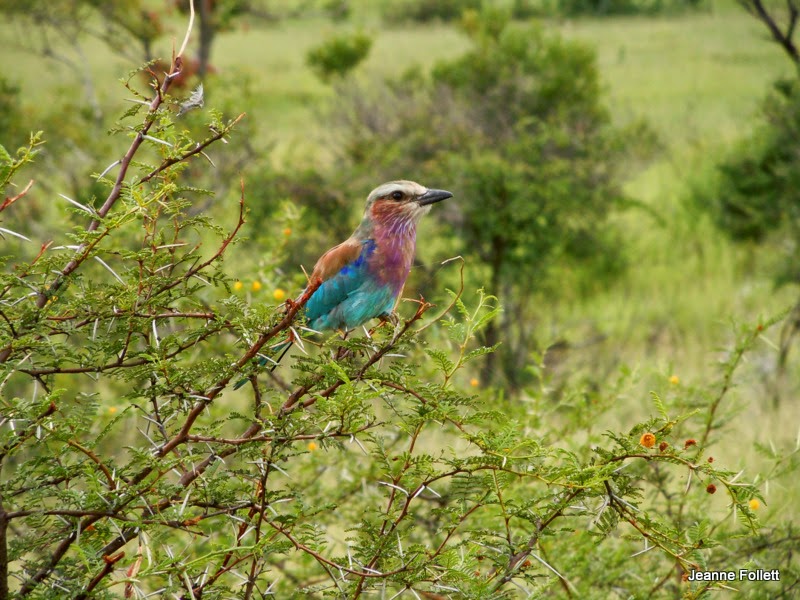The Africa Journals
Chapter 45
Kruger Unveiled
Too often. . .I would hear men
boast of the miles covered that day, rarely of what they had seen.
A loud, continual
noise wakes me. I open one eye half way
and look at the clock. Five A.M.—an
hour before the alarm is set to go off.
I
lie in my bed at the Protea Kruger Gate Hotel and ponder the noise. There it is again. Clatter (pause) clatter (pause) in rapid
succession. What could make such a noise? I try to remember what flooring is on the
walk outside my room. Wood? Cement?
Tiles?
That
was it. Square tiles. Clatter (pause) clatter (pause). Must be someone rolling a suitcase along the
tiles. Lots of suitcases. Must be the porters, I think, but are they
removing luggage or delivering it?
Sounds like both directions.
How
inconsiderate… I drift back to sleep…. CLATTER (PAUSE) CLATTER (PAUSE). Okay, no going back to sleep.
 |
| One row of rooms at Protea. |
Oh,
well. I shower and head for the dining
room for breakfast. Brian is there and
tells several of us about a noise waking him.
He says he stuck his head out the door of his room, ready to give
someone hell—but there was nobody there.
“Baboons
on the metal roof,” someone laughs. Oh,
good grief. Baboons running back and
forth across the roof. Of course. What a fun way to start the day!
I am stoked about an insect I saw on a ledge a couple doors from my room last night, and show the photo around.
Brian says, "I haven't seen one of those since I worked in the bush."
At
7 o’clock, we load up in the safari vehicles.
We will spend all day in the park.
 |
| The park is named for Paul Kruger, president of the Transvaal Republic, who signed the proclamation establishing the wildlife park in 1898. |
 |
| Kruger park covers 7580 square miles, contains 517 species of bird (some of which are transient), and 147 species of large mammals. And 3000 crocodiles. |
And right away, we see a couple zebras. South Africans pronounce it "zeh-bra." "You don't say "Deh-bra, do you? Brian asks, referring to the female name Deborah. The difference, we think, comes from the American "zee" and the British "zed."
 |
| The photo-bomber in the foreground is an impala. |
We head for an area where a leopard has been spotted. It takes us a while, but we finally see it in a tree.
And that makes it official. I have seen the Big Five--leopard, lion, rhino, elephant, and Cape buffalo, but in different parks. We drive on.
 |
| Finally! This Lilac-breasted roller held still for a portrait. |
And guess what? Another leopard, this one in a tree farther away than the first one.
 |
| Carmine bee-eater |
 |
| A steenbok, so small you could hold it in your lap. It can weigh up to 28 lbs. and stand 19 inches at the shoulder. |
 |
| Yes, I took a photo of a dead snake. I wasn't the only one. |
There's an elephant on the road in front of us. I'm remembering the elephants that challenged us in Chobe, and I will admit to being anxious.
 |
| A little flaring of the ears. Anger or cooling off? |
 |
| Whew. |
 |
| It gives us the eye, then grabs a clump of grass and stuffs it in its mouth. |
 |
| Another elephant approaches farther down the road. |
And then....
Resting in the shade under a palm.
 |
| Four lionesses |
Having a wonderful time in a mud wallow are two white rhinos.
 |
| Ahhhhhhhhh. |
Someone, maybe me, remarks that we lack only the Cape Buffalo on the Big Five list for the morning.
 | |||
| And there it is, the Cape buffalo. We have seen the Big Five in one morning in the rainy season. Amazing. |
 |
| Not a great shot, but as you can see, it was a long way off. |
Now, it's time for lunch.
















The leopards appeared to be totally non-engaged in being a "tour event"! The lilac-breasted roller bird took my breath away! The lionesses were into a serious nap until one lifted its head! And, I am amazed again at how "unwhite" the white rhinos are. The Cape Buffafo completed your Big Five...what a morning...no wonder the baboons woke you up early for what was to come! Patti and Cap
ReplyDeleteThe white rhino isn't called that because of their color. It comes from the Afrikaans word "wjd" which is derived from the Dutch word (wijd) for "wide," and that referred to the animal's square upper lip. The black rhino has a triangular shaped upper lip.
ReplyDelete